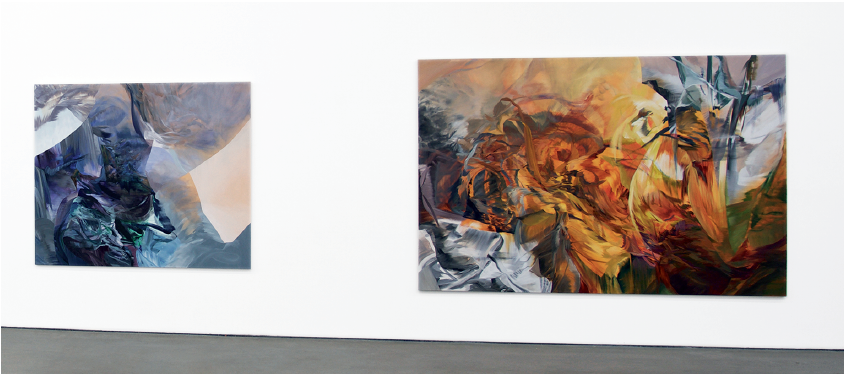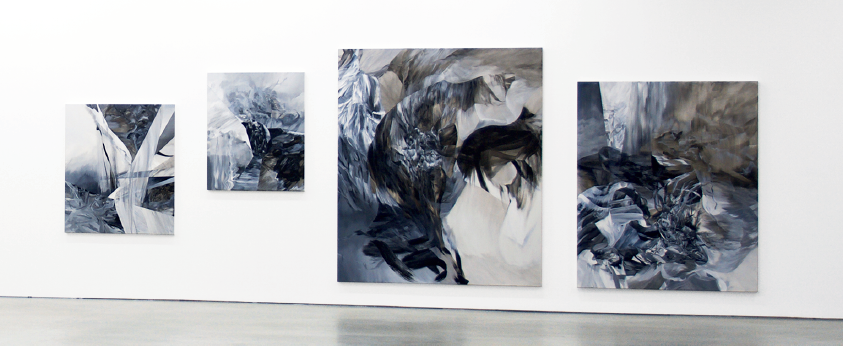Melanie Authier
Melanie Authier’s tour de force cross-Canada exhibition, “Contrarieties & Counterpoints,” most recently seen in Montreal at Galerie de l’UQAM, provides an excellent overview of the artist’s production and progress. Organized by the Thames Art Gallery in Chatham, Ontario, in 2017, in partnership with the other six venues, and curated by Robert Enright, the show has been or will be seen at the Ottawa Art Gallery, the Art Gallery of Guelph, the Kenderdine Art Gallery, Galerie de I’UQAM, Mount Saint Vincent University Art Gallery and upcoming at the Musée régional de Rimouski. The selection of works holds to the title, as do the individual pieces. The installation at Galerie de l’UQAM was thoughtful and powerful in its overall rhythmic organization, in the way the differences in the scale of the works (some of which are multi-panel) was visually maximized and in making sensitive use of the space, with its multifaceted coastline of changing contours and semi-separate rooms. Successfully utilizing the gallery environment allowed the works to breathe visually and intellectually, to function cohesively as a unit, as well as to maintain and represent their individual differences. Authier’s art is a marker for a contemporary practice that uncompromisingly re-engages with the modernist issue of seriality versus individual differentiation in producing her formalist artworks, and she succeeds at marrying those poles of discourse into a stylistic integrity.

Melanie Authier, installation view, “Contrarieties & Counterpoints,” 2017, Galerie de l’UQAM. Photo: Galerie de l’UQAM.
The work is eye-catching from the first glance—orchestral abstract landscapes, her paintings (and drawings) create sweeping atmospheric perspectives of complex space, which draw the viewer in by their powerful, frontal assault. Glowing colours, swooping vistas, vibrating architectonic planes and a wide toolbox of touch and application of marks and lines thrum and course through the work, which displays a broad knowledge of painting’s history, as well as her highly recognizable style.
Post-“death of painting” painting, the closest, clearest origin points for her work do seem to be the visionary sublime landscapes of 19th-century luminism and the 20th-century tradition of rigorous lyrical abstraction, which she fuses together in a subtle contemporary inflexion point, not so much deconstructionist as “hyper- or meta-real” in its vision of a reality unified in and by its very fragmentation. Looking at these works gives the impression of a space that is being created and de-created at once, seamlessly collaged and pulled in all directions.
Authier’s work is undoubtedly serial in nature, and has maintained a solidly coherent vision across the whole of her career. She has taken one strong step at a time, creating differentiated whole bodies of paintings by nuancing variations on her previous output and setting interesting variations on a cluster of themes that traverse vast territory. Making her grisaille series, for one example, posed the problem of how to allow her pictorial world to be presented without its accustomed access to richly chromatic tonalities. The answer was an emphatically bold grouping, possessing what feels satisfyingly like a more audible, pulsating baseline than would normally be the case. Likewise in the works on paper, in watercolour and ink—the change in scale and medium presented Authier with another opportunity to challenge her virtuosity. The result is a series of drawings that have a darker intimacy with no loss of either visual activity or acuity.

Melanie Authier, installation view, “Contrarieties & Counterpoints,” 2017, Galerie de l’UQAM. Photo: Galerie de l’UQAM.
A particularly eloquent, medium-sized, quiet work on canvas called The Thief’s Sun, at once tonally calm but richly colourful, displays an oblique space where figure and ground relationships have found a fugue-like perpetual motion, something true of all the work to varying degrees. Flatness and deep space negotiate with and betray each other as the painting points and counterpoints itself. This same visual and mental process echoes the experience of seeing and remembering the show after the fact, because Authier’s work has a tendency to make us want to retrace our steps and map out her compositions in our minds. This is an inevitable state when we follow the constant stream of baroque, diagonal highways and byways around these pieces. The work is visually generous and gives the viewer the impression that, for her, the acts of looking and of making are analogous, that they tend to be identified with one another, counterpointed and ongoing-ly. ❚
“Contrarieties & Counterpoints” was exhibited at Galerie de l’UQAM, Montreal, from October 24 to December 9, 2017. It will travel to the Mount Saint Vincent University Art Gallery, Halifax, and Musée Régional de Rimouski, Rimouski, QC, in 2018.
Benjamin Klein is a Montreal-based artist, writer and independent curator.

